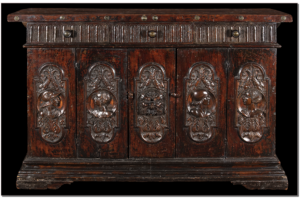Object of the Month: September 2024
Credenza
Walnut
Italian, 15th or 16th century
Gift of Paul W. Doll
In 1970, one of the Museum & Gallery’s primary early donors contributed this piece—a 15th-16th century carved walnut Credenza. As a furnishing, credenzas began as functioning sideboards, the top of which were meant for preparation and presentation of food. Long, low cabinets, often featuring drawers or doors for storing dishes and glasses, credenzas were often draped with expensive fabrics in wealthier homes.
Taken from medieval Latin, credenza means “belief” or “confidence” (sharing its derivation with our English word, “credence”). In our modern mindset, it is somewhat difficult to comprehend how the idea of “confidence” might have been wedded to a piece of wooden furniture, but it likely began as an association of the act of testing a noble’s food for poison.
Lest we discount such a probability, it’s helpful to understand the historical context. As far back as A.D. 1198, the Jewish doctor and philosopher Maimonides wrote a treatise on the subject for his employer, Sultan Saladin of Egypt and Syria. Maimonides gave detailed instruction, urging Saladin to insist his server or host eat a large portion of each dish before beginning to eat his own.
It seems unlikely to us that the need to test food could be so great, but historical examples may aid here. During the reign of Henry VIII in 16th-century England (the era in which M&G’s Credenza was constructed in Italy), the king employed some 200 persons in Hampton Court’s kitchens alone. While other European royalty and nobility may have employed smaller staffs, there was still ample opportunity for poisoning a ruler’s food. As servants delivered dishes to the dining room, they placed the dishes on the piece of furniture where credence tests for poisons were conducted, a literal credenza.
The face of M&G’s 16th-century walnut credenza was crafted of five solid boards, with overlay panels applied over each. Each of these panels is ornamented with detailed carving—four of these featuring profile busts of Renaissance figures (a technique called romayne). Each pair of these panels form doors, and the doors flank a fixed central panel carved with a grotesque mask. Hovering above the five front panels are three drawers, largely camouflaged by detailed fluted carving. The two end panels are simpler, each contain a distinctively Italian carved rosette and each lack the fluted frieze at the top. Along the front of the top plank are periodic dowel caps, indicating that the top is formed of smaller individual planks.
This style of carved Renaissance credenza is typical of both France and Italy, but individual elements indicate that this piece is most likely from Northern Italy, while still reflecting influences from the surrounding countries. Construction, materials, and ornamentation help to date the Credenza to the end of the 15th century to the middle of the 16th. Specifically, the detailed clothing of the men and women carved on the face of this credenza is like a Renaissance time capsule. The winged helmet worn by the first male (far left), for instance, depicts a sallet, a combat helmet which replaced the bascinet (helmet) in the mid-15th century. Later sallets dispensed with face protection and featured gracefully curved surfaces. These were preferred by more lightly armed troops and suggest that this credenza was built no earlier than about A.D. 1460.
Fascinating historic pieces such as M&G’s Credenza provide windows through which we understand the lives and culture of those who came before us and, in this case, an era upon which much of our modern Western civilization is built.
Dr. Stephen B. Jones, M&G volunteer
